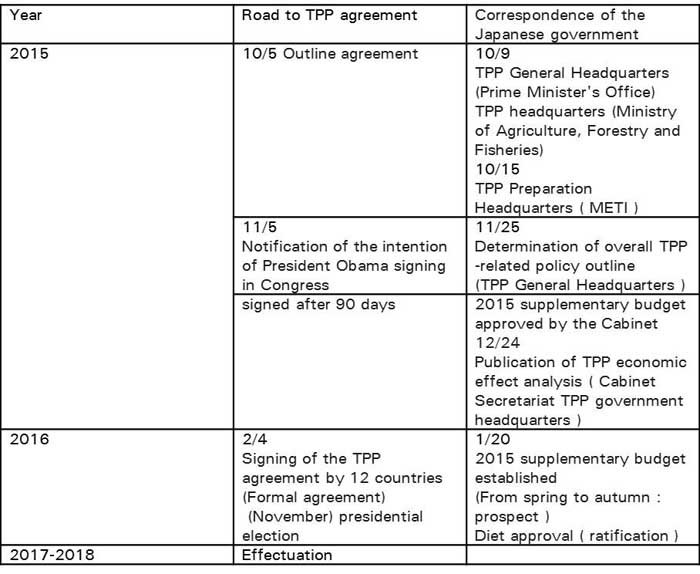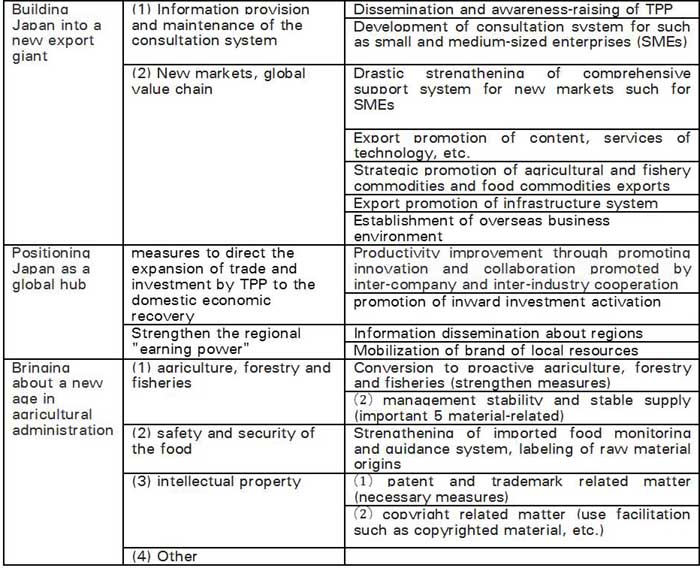Trends after TPP agreement outline agreement

[Conditions of TPP entry into force]
When a country has completed its domestic treaty-making processes, it will notify other TPP countries that it has done all that is required for the Agreement to enter into force. The Trans-Pacific Partnership Agreement will enter into force 60 days after all original signatories have notified completion of their domestic legal procedures. If this has not occurred within two years after signing, the Agreement will enter into force 60 days after the expiry of that two-year period if at least six original signatories accounting for 85 % of the combined gross domestic product of the original signatories have ratified the agreement.
(Reference: GDP composition ratio of the participating 12 countries; US about 60%; Japan about 17%)
The Government’scorresponding measures regarding TPP: An Overview
(1) Development of TPP Policy Outline (2015.11.25)
【The basic concepts】
- Clarify the goals of the policy which is truly necessary and which is to dispel anxiety about the impact of TPP
- Performs a constant inspection and review of major policies while concrete content of policy mix for 1) strategy necessary for further industrialization of agriculture, forestry and fisheries industry, 2) policy necessary for further productivity improvement and overseas expansion as well as business expansion of Japanese industry set by 2016 Autumn.
[The main measures towards the realization of the basic concepts]

The publication of the economic impact analysis (of TPP) (2015.12.24)
- Analysis of the economic effects on Japan's macro economy in case the TPP agreement enters into force
- Use of GTAP: using the (Global Trade Analysis Project: national trade analysis project) model and comparing the 2013 analysis (immediately eliminate tariffs all, no domestic measures) with the comprehensive benefit analysis reflecting the impact on tariffs based on the agreement contents as well as cost reduction of non-tariff, trade and investment promotion effects, and the productivity effect, etc.
[The expected growth mechanism]

【The analysis result】
● At the time of the transition to the equilibrium state, real GDP + 2.6% increase, expansion effect of about 14 trillion yen (Converted using 2014 GDP), labor supply is about 80 million people, up
(3) Corresponding in the 2015 supplementary budget
TPP measures total 3,403 billion yen (supplementary budget total 3 trillion 5,030 billion yen)
[Main contents]
1. Land improvement projects 99 billion yen
Support for the integral development of further large compartmentalization and underground irrigation facilities of agricultural land, and support for such as further high-function of upland and orchards, and conversion of paddy fields to upland in order to encourage a shift to high-profit crops.
2. Production areas’ power-up business 50.5 billion yen (funds)
Support for conversion to a highly profitable crop and cultivation system through introduction of high-performance machinery and/or facilities and through restructure and reform of collecting shipment facility based on farming strategy of the region.
3. Measure to strengthening livestock, dairy profitability special measures business 61 billion yen (funds)
Support profitability improvement measures such as leasing necessary machinery, facility development and introduction of livestock for the main management body based on the livestock cluster plan.
(4) Corresponding 2016 fiscal year budget
Expand the "proactive agriculture, forestry and fisheries" such as export promotion and management improvement (MAFF: total budget of 2.3 trillion yen)
[Main contents]
|
Date submitted: May 30, 2016
Reviewed, edited and uploaded: May 30, 2016
|


Trends in TPP agreement and government correspondence: An Overview
Trends after TPP agreement outline agreement
[Conditions of TPP entry into force]
When a country has completed its domestic treaty-making processes, it will notify other TPP countries that it has done all that is required for the Agreement to enter into force. The Trans-Pacific Partnership Agreement will enter into force 60 days after all original signatories have notified completion of their domestic legal procedures. If this has not occurred within two years after signing, the Agreement will enter into force 60 days after the expiry of that two-year period if at least six original signatories accounting for 85 % of the combined gross domestic product of the original signatories have ratified the agreement.
(Reference: GDP composition ratio of the participating 12 countries; US about 60%; Japan about 17%)
The Government’scorresponding measures regarding TPP: An Overview
(1) Development of TPP Policy Outline (2015.11.25)
【The basic concepts】
[The main measures towards the realization of the basic concepts]
[The expected growth mechanism]
[1] If you would like to read the original paper in Japanese, please refer to the website (http://www.pref.shizuoka.jp/kikaku/documents/03-01doukou.pdf ).
Date submitted: May 30, 2016
Reviewed, edited and uploaded: May 30, 2016